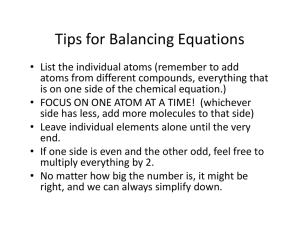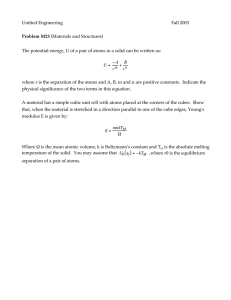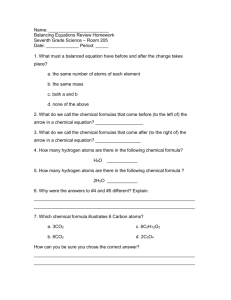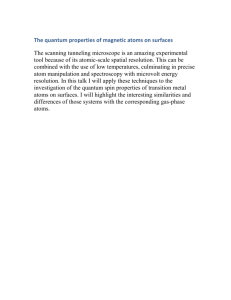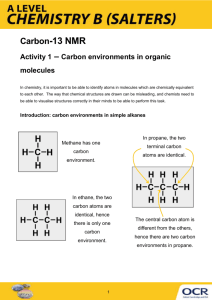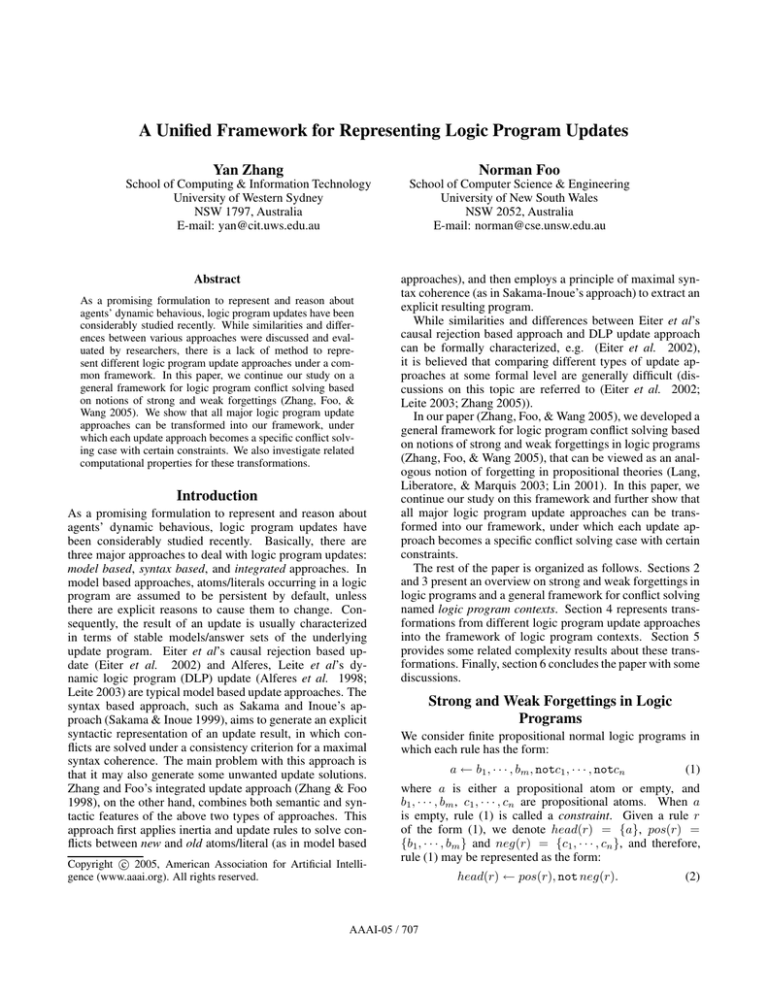
A Unified Framework for Representing Logic Program Updates
Yan Zhang
School of Computing & Information Technology
University of Western Sydney
NSW 1797, Australia
E-mail: yan@cit.uws.edu.au
Abstract
As a promising formulation to represent and reason about
agents’ dynamic behavious, logic program updates have been
considerably studied recently. While similarities and differences between various approaches were discussed and evaluated by researchers, there is a lack of method to represent different logic program update approaches under a common framework. In this paper, we continue our study on a
general framework for logic program conflict solving based
on notions of strong and weak forgettings (Zhang, Foo, &
Wang 2005). We show that all major logic program update
approaches can be transformed into our framework, under
which each update approach becomes a specific conflict solving case with certain constraints. We also investigate related
computational properties for these transformations.
Introduction
As a promising formulation to represent and reason about
agents’ dynamic behavious, logic program updates have
been considerably studied recently. Basically, there are
three major approaches to deal with logic program updates:
model based, syntax based, and integrated approaches. In
model based approaches, atoms/literals occurring in a logic
program are assumed to be persistent by default, unless
there are explicit reasons to cause them to change. Consequently, the result of an update is usually characterized
in terms of stable models/answer sets of the underlying
update program. Eiter et al’s causal rejection based update (Eiter et al. 2002) and Alferes, Leite et al’s dynamic logic program (DLP) update (Alferes et al. 1998;
Leite 2003) are typical model based update approaches. The
syntax based approach, such as Sakama and Inoue’s approach (Sakama & Inoue 1999), aims to generate an explicit
syntactic representation of an update result, in which conflicts are solved under a consistency criterion for a maximal
syntax coherence. The main problem with this approach is
that it may also generate some unwanted update solutions.
Zhang and Foo’s integrated update approach (Zhang & Foo
1998), on the other hand, combines both semantic and syntactic features of the above two types of approaches. This
approach first applies inertia and update rules to solve conflicts between new and old atoms/literal (as in model based
c 2005, American Association for Artificial IntelliCopyright gence (www.aaai.org). All rights reserved.
Norman Foo
School of Computer Science & Engineering
University of New South Wales
NSW 2052, Australia
E-mail: norman@cse.unsw.edu.au
approaches), and then employs a principle of maximal syntax coherence (as in Sakama-Inoue’s approach) to extract an
explicit resulting program.
While similarities and differences between Eiter et al’s
causal rejection based approach and DLP update approach
can be formally characterized, e.g. (Eiter et al. 2002),
it is believed that comparing different types of update approaches at some formal level are generally difficult (discussions on this topic are referred to (Eiter et al. 2002;
Leite 2003; Zhang 2005)).
In our paper (Zhang, Foo, & Wang 2005), we developed a
general framework for logic program conflict solving based
on notions of strong and weak forgettings in logic programs
(Zhang, Foo, & Wang 2005), that can be viewed as an analogous notion of forgetting in propositional theories (Lang,
Liberatore, & Marquis 2003; Lin 2001). In this paper, we
continue our study on this framework and further show that
all major logic program update approaches can be transformed into our framework, under which each update approach becomes a specific conflict solving case with certain
constraints.
The rest of the paper is organized as follows. Sections 2
and 3 present an overview on strong and weak forgettings in
logic programs and a general framework for conflict solving
named logic program contexts. Section 4 represents transformations from different logic program update approaches
into the framework of logic program contexts. Section 5
provides some related complexity results about these transformations. Finally, section 6 concludes the paper with some
discussions.
Strong and Weak Forgettings in Logic
Programs
We consider finite propositional normal logic programs in
which each rule has the form:
a ← b1 , · · · , bm , notc1 , · · · , notcn
(1)
where a is either a propositional atom or empty, and
b1 , · · · , bm , c1 , · · · , cn are propositional atoms. When a
is empty, rule (1) is called a constraint. Given a rule r
of the form (1), we denote head(r) = {a}, pos(r) =
{b1 , · · · , bm } and neg(r) = {c1 , · · · , cn }, and therefore,
rule (1) may be represented as the form:
AAAI-05 / 707
head(r) ← pos(r), not neg(r).
(2)
Sometimes, (2) is also simply denoted by head(r) ←
body(r). We assume that readers are familiar with the stable
model semantics of normal logic programs. A program Π
is called consistent if it has a stable model. An atom a is
entailed from Π, denoted as Π |= a if a is in every stable
model of Π.
Given a program Π, a rule r ∈ Π is called redundant if
r is of one of the following forms: (1) head(r) 6= ∅ and
head(r) ⊆ pos(r), or (2) pos(r) ∩ neg(r) 6= ∅. It is easy
to show that removing redundant rules from a program will
not affect the stable model of this program.
Definition 1 (Program reduction) Let Π be a program and
p an atom. We define the reduction of Π with respect to p, denoted as Reduct(Π, {p}), to be a program obtained from Π
by (1) for each rule r with head(r) = p and each rule r 0 with
p ∈ pos(r0 ), replacing r 0 with a new rule r 00 : head(r0 ) ←
(pos(r)∪pos(r 0 )−{p}), not(neg(r)∪neg(r 0 )); (2) if there
is such rule r 0 in Π and has been replaced by r 00 in (1), then
removing rule r from the remaining program. Let P be a
set of atoms. Then the reduction of Π with respect to P is
inductively defined as follows:
Reduct(Π, ∅) = Π,
Reduct(Π, P ∪ {p}) = Reduct(Reduct(Π, {p}), P ).
Note that in our program reduction definition, step (1) is
the same as logic program unfolding (Brass & Dix 1999).
While unfolding is to eliminate positive body occurrences
of an atom in a logic program, the reduction, on other hand,
is further to remove those rules with heads of this atom.
Example 1 Let Π1 = {a ← notb, a ← d, c ← a, note},
Π2 = {a ← c, notb, c ← notd}, and Π3 = {a ← b, b ←
notd, c ← a, note}. Then Reduct(Π1 , {a}) = {c ←
notb, note, c ← d, note}, Reduct(Π2 , {a}) = Π2 , and
Reduct(Π3 , {a, b}) = {c ← notd, note}. Definition 2 (Strong forgetting) Let Π be a logic program,
and p an atom. We define a program to be the result of
strongly forgetting p in Π, denoted as SForgetLP(Π, {p}),
if it is obtained from the following transformation:
1.
2.
3.
4.
5.
6.
Π0 = Reduct(Π, {p});
Π0 = Π0 − {r | r is a redundant rule};
Π0 = Π0 − {r | head(r) = p};
Π0 = Π0 − {r | p ∈ pos(r)};
Π0 = Π0 − {r | p ∈ neg(r)};
SForgetLP (Π, {p}) = Π0 .
follows. If we think neg(r) is a part of support of head(r),
then when p ∈ neg(r) is forgotten, head(r)’s entire support
is lost as well. Clearly, such treatment of negation as failure in forgetting is quite strong in the sense that more atoms
may be lost together with not p. Therefore we call this kind
of forgetting strong forgetting. Definition 2 can be easily extended to the case of forgetting a set of atoms:
SForgetLP (Π, ∅) = Π,
SForgetLP (Π, P ∪ {p}) =
SForgetLP (SForgetLP (Π, {p}), P ).
With a different way of dealing with negation as failure,
we have a weak version of forgetting. We define a program to be the result of weakly forgetting p in Π, denoted
as WForgetLP (Π, {p}), exactly in the same way as in Definition 2 except that Step 5 is replaced by the following step:
Π0 = (Π0 − Π∗ ) ∪ Π† , where
Π∗ = {r | p ∈ neg(r)} and
Π† = {r0 | r0 : head(r) ←
pos(r), not(neg(r) − {p}) where r ∈ Π∗ }.
It is easy to see that weakly forgetting p from a rule having
p in its negative body will result in the absence of p in any
case. The notion of weakly forgetting a set of atoms, denoted
as WForgetLP (Π, P ), can be defined in a similar way:
WForgetLP (Π, ∅) = Π,
WForgetLP (Π, P ∪ {p}) =
WForgetLP (WForgetLP (Π, {p}), P ).
Example 2 Π = {a ← b, notc, a ← note, d ← a, e, e ←
nota}. Then SForgetLP (Π, {a}) = {d ← b, e, notc}, and
WForgetLP(Π, {a}) = {d ← b, e, notc, e ←}. A General Framework for Solving Logic
Program Conflicts
We define a general framework called logic program context
to represent a knowledge system which consists of multiple
agents’ knowledge bases. We consider the issue of conflicts
occurring in the reasoning within the underlying logic program context. The notions of strong and weak forgettings
provide an effective way to solve such conflicts.
Definition 3 (Logic program context) A logic program
context is a n-ary tuple Σ = (Φ1 , · · · , Φn ), where each Φi
is a triplet (Πi , Ci , Fi ) - Πi and Ci are two logic programs,
and Fi ⊆ Atom(Πi ) is a set of atoms. We also call each Φi
the ith component of Σ. Σ is consistent if for each i, Πi ∪ Ci
is consistent. Σ is conflict-free if for any i and j, Πi ∪ Cj is
consistent.
In Definition 2, step 1 is just to perform reduction on
Π with respect to atom p. Step 2 is to remove all redundant rules which may be introduced by the reduction of Π
with respect to p. Steps 3 and 4 are to remove those rules
which have p as the head or in the positive body. The intuitive meaning of Steps 3 and 4 is that after forgetting p,
any atom’s information in rules having p as their heads or
positive bodies will be lost because they are all relevant to p,
i.e. these atoms either serve as a support for p or p is in part
of the supports for these atoms. On the other hand, Step 5
states that any rule containing p in its negation as failure part
will also be removed. The consideration for this step is as
In the above definition, for a given logic program context
Σ, each component Φi represents agent i’s local situation,
where Πi is agent i’s knowledge base, Ci is a set of constraints that agent i should comply and will not change in
any case, and Fi is a set of atoms that agent i may forget if
necessary.
Now the problem of conflict solving under this setting can
be stated as follows: given a logic program context Σ =
(Φ1 , · · · , Φn ), which may not be consistent or conflict-free,
how can we find an alternative logic program context Σ0 =
(Φ01 , · · · , Φ0n ) such that Σ0 is conflict-free and is closest to
the original Σ in some sense?
AAAI-05 / 708
Definition 4 (Solution) Let Σ = (Φ1 , · · · , Φn ) be a logic
program context, where each Φi = (Πi , Ci , Fi ). We call a
logic program context Σ0 a solution that solves conflicts in
Σ, if Σ0 satisfies the following conditions:
1. Σ0 is conflict-free;
2. Σ0 = (Φ01 , · · · , Φ0n ), where Φ0i = (Π0i , Ci , Fi ), and Π0i =
SForgetLP (Πi , Pi ) or Π0i = WForgetLP (Πi , Pi ) for
some Pi ⊆ Fi .
We denote the set of all solutions of Σ as Solution(Σ).
Definition 5 (Ordering on solutions) Let Σ, Σ0 and Σ00 be
three logic program contexts, where Σ0 , Σ00 ∈ Solution(Σ).
We say that Σ0 is closer or as close to Σ as Σ00 , denoted
as Σ0 Σ Σ00 , if for each i, Φ0i = (Π0i , Ci , Fi ) ∈ Σ0 and
Φ00i = (Π00i , Ci , Fi ) ∈ Σ00 , where Π0i = SForgetLP(Πi , Pi )
or Π0i = WForgetLP (Πi , Pi ) for some Pi ⊆ Fi , and
Π00i = SForgetLP(Πi , Qi ) or Π00i = WForgetLP (Πi , Qi )
for some Qi ⊆ Fi respectively, we have Pi ⊆ Qi ⊆ Fi . We
denote Σ0 ≺Σ Σ00 if Σ0 Σ Σ00 and Σ00 6Σ Σ0 .
Definition 6 (Preferred solution) Let Σ and Σ0 be two
logic program contexts. We say that Σ0 is a preferred solution of Σ, if Σ0 ∈ Solution(Σ) and there does not exist
another Σ00 ∈ Solution(Σ) such that Σ00 ≺Σ Σ0 .
Applications of this conflict solving approach in complex
problem domains, and semantic and computational foundations in relation to strong and weak forgettings and logic
program contexts have been studied in detail in our paper
(Zhang, Foo, & Wang 2005).
Representing Logic Program Updates
In this section, we show that three major logic program update approaches can be transformed into the framework of
logic program contexts, in which all these update approaches
become special cases of conflict solving problems with different types of constraints.
Representing Causal Rejection Based Approach
Eiter et al’s update approach is based on a principle called
causal rejection where a sequence of logic program updates
is allowed (Eiter et al. 2002). Let P = (Π1 , · · · , Πn ), where
Π1 , · · · , Π1 are extended logic programs, be an (extended
logic program) update sequence and A a set of atoms. We
say that P is over A iff A represents the set of all atoms
occurring in the rules in Π1 , · · · , Πn . We use LitA to denote the set of all literals whose corresponding atoms are in
A. We assume a set A∗ of atoms extending A by new and
pairwise distinct atoms rej(r) and ai , for each rule r occurring in Π1 , · · · , Πn and each atom a ∈ A. Then Eiter et al’s
update process is defined by the following two definitions
(here we only consider ground extended logic programs in
our investigation).
Definition 7 (Eiter et al. 2002) Given an update sequence
P = (Π1 , · · · , Πn ) over a set of atoms A, the update program P/ = Π1 /· · ·/Πn over A∗ consisting of the following
items:
1. all constraints in Π1 , · · · , Πn (recall that a constraint is a
rule with an empty head);
2. for each r in Πi (1 ≤ i ≤ n):
li ← body(r), not rej(r) if head(r) = {l};
3. for each r ∈ Πi−1 (2 ≤ i ≤ n):
rej(r) ← body(r), ¬li if head(r) = {l};
4. for each literal l occurring in Π1 ∪ · · · ∪ Πn :
li−1 ← li (1 < i ≤ n), l ← l1 .
Intuitively, this program expresses the derivation of a literal l, beginning at Πn downwards to Π1 . A rule in Πn
is always applicable where a rule in Πi−1 can only be applicable if it is not refuted by a literal derived at Πi that is
incompatible with head(r). Persistence of a literal l propagates a locally derived value for l downwards to Π1 , where
the local value of l is made global.
Definition 8 (Eiter et al. 2002) Let P = (Π1 , · · · , Πn ) be
an update sequence over A. Then S ⊆ LitA is an update
answer set of P iff S = S 0 ∩ LitA for some answer set S 0 of
P/ . The collection of all update answer sets of P is denoted
by U(P).
As an example, consider an update sequence P =
(Π1 , Π2 , Π3 ), where Π1 , Π2 and Π3 consist of the following
rules respectively (Eiter et al. 2002),
Π1 :
r1 : sleep ← not tv on,
r2 : night ←,
r3 : tv on ←,
r4 : watch tv ← tv on;
Π2 :
r5 : ¬tv on ← power f ailure,
r6 : power f ailure ←,
Π3 :
r7 : ¬power f ailure ←.
According to Definitions 7 and 8, it is easy to see that
P = (Π1 , Π2 , Π3 ) has a unique update answer set S =
{¬power f ailure, tv on, watch tv, night}, which is consistent with our intuition.
In order to transform this update approach into our framework of logic program context, we first re-formulate this
approach in a normal logic program setting. In particular,
given an update sequence P = (Π1 , · · · , Πn ) over A, we extend the set A to A by adding atom a to A for each a ∈ A.
Then by replacing each negative atom ¬a occurring in Πi
with a, we obtain a translated (normal logic program) update sequence P = (Π1 , · · · , Πn ) over A
∗
We also extend set A to A by including new atoms
rej(r), ai and ai for each rule r in Π1 , · · · , Πn and each
pair of atoms a, a ∈ A. Then following Definition 7, we can
obtain the corresponding update program P / which is also
a normal logic program. We also call a stable model of P/
update stable model of P.
Proposition 1 Let P = (Π1 , · · · , Πn ) be an update sequence, P/ the update program of P, and P and P/ the
corresponding translations of P and P/ respectively as described above. S ⊆ LitA is an update answer set of
P iff there is an update stable model S of P such that
S = (S ∩ A) ∪ {¬a | a ∈ S}.
AAAI-05 / 709
Having Proposition 1, we only need to consider a transformation from a normal logic program update sequence
P = (Π1 , · · · , Πn ), where P is translated from an extended
logic program update sequence P as described above, to a
conflict solving problem under the framework of logic program contexts.
Definition 9 Let P = (Π1 , · · · , Πn ) (n > 1) be a normal
logic program update sequence over A. We specify a sequence of logic program contexts ΩCR = (Σ1 , · · · , Σn−1 )1
∗
∗
over the set of atoms B = A ∪ {lai , lai | ai , ai ∈ A , i =
1, · · · , n} where lai and lai are newly introduced atoms:
∗
∗
1. Σ1 = ((Π1 , ∅, F1 ), (∅, C1 , ∅)), where Π1 consists of the
following rules:
(a) all constraints in Π1 , · · · , Πn ;
(b) for each r ∈ Πi : a ← body(r) or a ← body(r)
(1 ≤ i ≤ n),
ai ← body(r), not lai , ai ← B(r), not lai respectively,
(c) for each a, a in A,
ai−1 ← ai ,
ai−1 ← ai (1 < i ≤ n),
a ← a1 ,
a ← a1 .
(d) F1 = {lan−1 , lan−1 | ∀a ∈ A},
(e) C1 = {← an−1 , an , ← an−1 , an | ∀a ∈ A};
∗
2. Σi = ((Πi , ∅, Fi ), (∅, Ci , ∅) (1 < i ≤ n − 1), where
∗
†
†
(a) Πi = Πi−1 , and Πi−1 is in a preferred solution of
†
Σi−1 : Σ0i−1 = ((Πi−1 , ∅, Fi−1 ), (∅, Ci−1 , ∅)),
(b) Fi = {lan−i , lan−i | ∀a ∈ A},
(c) Ci = {← an−i , an−i+1 , ← an−i , an−i+1 | ∀a ∈ A}.
A set of atoms S 0 ⊆ B is called a model of ΩCR if S 0 is a
†
†
stable model of Πn−1 , where Πn−1 is in a preferred solution
†
of Σn−1 : Σ0n−1 = ((Πn−1 , ∅, Fn−1 ), (∅, Cn−1 , ∅)).
Let us take a closer look at Definition 9. Given an update
sequence P = (Π1 , · · · , Πn ), Definition 9 specifies a sequence of logic program contexts ΩCR = (Σ1 , · · · , Σn−1 ),
where each Σi solves certain conflicts embedded in P. Σ1
∗
represents the first level of conflict solving, where Π1 is similar to P/ except that the possible conflict between an−1 and
an (or an−1 and an ) has been reformulated as a constraint
← an−1 , an (or ← an−1 , an resp.) in C1 . Note that in rules
specified in 1.(b) of Definition 9: ai ← body(r), not lai ,
ai ← body(r), not lai , formulas not lan−1 and not lan−1
(here i = n − 1) are introduced to solve the conflict between
an−1 and an (or an−1 and an resp.).
Observe that Σ1 only solves conflicts between atoms at
level n − 1. For example, if both an−1 and an can be de∗
rived from Π1 , then rule an−1 ← body(r), not lan−1 will be
eliminated from Π1 by strongly forgetting atom lan−1 under
the constraint ← an−1 , an in C1 .
1
Note that when n = 1 our transformation becomes trivial since
we can simply specify ΩCR to consist of a single logic program
context Σ = ((Π1 , ∅, ∅), (∅, ∅, ∅)). In this case Σ has a (preferred)
solution iff Π1 is consistent. So in the rest of the paper we will only
consider the case n > 1.
In the sequence ΩCR = (Σ1 , · · · , Σn−1 ), conflicts are
solved in a downwards manner with respect to the update
sequence P = (Π1 , · · · , Πn ), where each Σi (i > 1) is
specified for the purpose of solving conflicts between atoms
an−i and an−i+1 (or an−i and an−i+1 ).
Example 3 Consider the TV example mentioned earlier
again, where P = (Π1 , Π2 , Π3 ) is an update sequence. It
is easy to translate P to the corresponding normal logic program update sequence P = (Π1 , Π2 , Π3 ), where ¬tv on
and ¬power f ailure are replaced by atoms tv on and
power f ailure respectively. According to Definition 9, we
then specify a sequence of logic program contexts ΩCR =
(Σ1 , Σ2 ) to solve the conflict occurring in P. Σ1 =
∗
∗
((Π1 , ∅, F1 ), (∅, C1 , ∅)), where Π1 consists of the following
rules2 :
sleep1 ← not tv on, not lsleep1 ,
night1 ← not lnight1 ,
tv on1 ← not ltv on1 ,
watch tv1 ← tv on, not lwatch tv1 ,
tv on2 ← power f ailure, not ltv on2 ,
power f ailure2 ← not lpower f ailure2 ,
power f ailure3 ← not lpower f ailure3 ,
night ← night1 ,
tv on ← tv on1 ,
watch tv ← watch tv1 ,
tv on1 ← tv on2 ,
tv on ← tv on1 ,
power f ailure2 ← power f ailure3 ,
power f ailure1 ← power f ailure2 ,
power f ailure ← power f ailure1 ,
power f ailure1 ← power f ailure2 ,
power f ailure ← power f ailure1 ,
F1 = {lpower f ailure2 , lpower f ailure2 }, and
C1 = {← power f ailure2, power f ailure3 }.
∗
It is easy to see that Σ1 is not conflict free since Π1 ∪ C1 is
not consistent (i.e it has no stable model). To specify Σ2 , we
first need to obtain a preferred solution of Σ1 . In fact Σ1 has
†
a unique preferred solution Σ01 = ((Π1 , ∅, F1 ), (∅, C1 , ∅)),
†
∗
∗
where Π1 = SForgetLP (Π1 , {lpower f ailure2 }) = Π1 −
{power f ailure2 ← not lpower f ailure2 }.
†
Now we specify Σ2 = ((Π1 , ∅, F2 ), (∅, C2 , ∅)), where
F2 = {ltv on1 , ltv on1 } and C2 = {← tv on1 , tv on2 }.
Note that Σ2 is already conflict free. So by ignoring
those atoms with subscripts, ΩCR has a unique model
{power f ailure, tv on, watch tv, night}, which is the
same as the update stable model of update sequence P. Theorem 1 Let P be a normal logic program update
sequence over the set of atoms A, and ΩCR =
(Σ1 , · · · , Σn−1 ) a sequence of logic program contexts as
specified in Definition 9. A subset S of A is an update stable
model of P iff ΩCR has a model S 0 such that S = S 0 ∩ A.
2
To avoid unnecessarily tedious details, here we omit some ir∗
relevant rules and atoms from Π1 , F1 and C1 . The same for Σ2 .
AAAI-05 / 710
Representing Dynamic Logic Programming
Logic program update based on dynamic logic programming
(DLP) (or simply called DLP update approach) was proposed by Alferes, Leite, Pereira, et al (Alferes et al. 1998),
and then extended for various purposes (Leite 2003). Using
a similar technique as described in last subsection, we can
also transform the DLP update approach into the framework
of logic program contexts and prove an equivalence theorem
between these two formulations.
Due to a space limit, the details are referred to our full
paper. Here we only highlight that: compared to the transformation presented earlier, the main feature to transform a
dynamic update program P⊕ = Π1 ⊕ · · · ⊕ Πn (readers are
referred to (Leite 2003) for the definition of P⊕ ) to a sequence of logic program contexts ΩDLP = (Σ1 , · · · , Σn ) is
to employ an upwards conflict solving policy to solve possible conflicts between atoms (recall Definition 9 uses a downwards method to solve conflicts among atoms). For example, for each pair of inheritance rules in P⊕ :
ai ← ai−1 , not aPi , and
ai−1 ← ai−1 , not aPi
we replace them with the following rules in ΩDLP :
ai ← ai−1 , not lai ,
lai ← not hai ,
la i ← a P i ,
ai−1 ← ai−1 , not lai ,
lai ← not hai ,
lai ← aPi ,
and under constraints ← ai , aPi and ← ai , aPi , conflicts are
solved by weakly forgetting atoms from {hai , hai }3 .
Representing Updates as Constraints for Conflict
Solving
Sakama and Inoue’s update approach (or simply denoted
as SI approach) is viewed as a typical syntax based logic
program update approach (Sakama & Inoue 1999), which
solves conflicts between two programs on a basis of syntactic coherence. In (Zhang, Foo, & Wang 2005), we have
showed that there is a simple one-to-one correspondence between SI approach and our conflict solving framework.
From previous descriptions and (Zhang, Foo, & Wang
2005), we observe that the key step to transform an update
approach into a sequence of logic program contexts (or one
logic program context like the case of SI approach) is to
construct the underlying constraints for conflict solving. In
both Eiter et al’s causal rejection and DLP approaches, constraints are specified based on atoms, e.g. ← an−i , an−i+1
in ΩC R , and ← ai , aP − in ΩDLP .
i
For SI approach, on the other hand, the underlying constraints are specified as the entire update program. For instance, consider the update of Π1 by Π2 using SI approach,
the corresponding logic program context for this update is
of the form Σ = ((Π, ∅, F), (∅, Π2 , ∅)), in which program
Π2 serves as constraints for conflict solving (Zhang, Foo, &
Wang 2005).
From the above observation, we can see that the main difference between model based and syntax based update ap3
Recall that in ΩCR conflicts are solved through strong forgettings.
proaches is to solve conflicts under different types of constraints, namely atoms based and program based constraints
respectively.
Representing Integrated Update Approach
Different from both model based and syntax based approaches, Zhang and Foo’s update approach integrated both
desirable semantic and syntactic features of (extended) logic
program updates (Zhang & Foo 1998). Their approach
also solves default conflicts caused by negation as failure
in logic programs by using a prioritized logic programming
language. Consequently, Zhang and Foo’s update approach
can generate an explicit resulting program for a logic program update and also avoid some undesirable solutions embedded in Sakama-Inoue’s approach (Zhang 2005).
Since we do not consider default conflict solving in this
paper, we will only focus on the transformation from first
part of Zhang-Foo’s update approach, that is, the conflict
(contradiction) elimination, into a logic program context.
Let Π1 and Π2 be two extended logic programs. Updating
Π1 with Π2 consists of two stages. Step (1): Simple fact
update - updating an answer set S of Π1 by program Π2 . The
result of this update is a collection of sets of literals, denoted
as Update(S, Π2 ). Step (2): Select a S 0 ∈ Update(S, Π2 ),
and extract a maximal subset Π∗ of Π1 such that program
Π∗ ∪ {l ←| l ∈ S 0 } (or simply represented as Π∗ ∪ S 0 ) is
consistent. Then Π∗ ∪ Π2 is called a resulting program of
updating Π1 with Π2 .
Note that in Step (1), the simple fact update is achieved
through a prioritized logic programming (Zhang & Foo
1998). Recently, Zhang proved an equivalence relationship between the simple fact update and Sakama and Inoue’s program update (Zhang 2005): Update(S, Π2 ) =
S
S(SI
S -Update(Π(S), Π2 )), where Π(S) = {l ←| l ∈ S},
and S(SI -Update(Π(S), Π2 )) is the class of all answer
sets of resulting programs after updating Π(S) by Π2 using
Sakama-Inoue’s approach.
Example 4 Consider two extended logic programs Π1 and
Π2 as follows:
Π1 :
Π2 :
a ←,
b ← a,
c ← b,
¬c ← b.
d ← not e.
Π1 has a unique answer set {a, d}.
Then Step
(1) Zhang-Foo’s simple fact update of {a, d} by Π2 ,
Update({a, d}, Π2 ), which is equivalently to update {a ←,
d ←} with Π2 using Sakama-Inoue’s approach, will contain a single set {a, b, ¬c, d}. Applying Step (2), we obtain the final update result {a ←, d ← not e} ∪ Π2 . Note
that directly using Sakma-Inoue’s approach to update Π1
with Π2 will obtain an extra unwanted resulting program
{c ← b, d ← not e} ∪ Π2 . As we have already provided a transformation from
Sakama-Inoue’s approach to a logic program context, to
show that Zhang-Foo’s update approach can also be represented within our framework, it is sufficient to only transform Step (2) above into a conflict solving problem under
certain logic program context.
AAAI-05 / 711
As before, given two extended logic programs Π1 and Π2
over the set of atoms A, we extend A to A with new atom
a for each a ∈ A. Then by replacing each ¬a in S 0 and Π2
with a, we obtain the corresponding normal logic programs
Π1 and Π2 respectively. Suppose Update(S, Π2 ) is the result of the simple fact update, where S is a stable model of
Π1 .
Definition 10 Let Π1 , Π2 , and Update(S, Π2 ) be defined
as above, and S 0 ∈ Update(S, Π2 ). We specify a logic program context ΣZF = ((Π0 1 , ∅, F), (∅, C, ∅)) over the set of
atoms A ∪ {lr | r ∈ Π1 } where lr are newly introduced
atoms:
1. Π0 1 consists of rules: (a) for each rule r : head(r) ←
body(r) in Π1 , head(r) ← body(r), not lr is in Π0 1 , and
(b) S 0 ⊆ Π0 1 ,
2. F = {lr | r ∈ Π1 },
3. C = {← a, a | a, a ∈ A}.
The following theorem shows that Step (2) in ZhangFoo’s approach can be precisely characterized by a logic
program context specified in Definition 10.
Theorem 2 Let Π1 , Π2 , and Update(S, Π2 ) be defined as
∗
above, and S 0 ∈ Update(S, Π2 ). Π is a maximal subset
∗
of Π1 such that Π0 = Π ∪ S 0 is consistent iff Π0 is in a
preferred solution of ΣZF : Σ0ZF = ((Π0 , ∅, F), (∅, C, ∅)).
Computational Issues
In this section, we consider the related computational issues regarding the transformations from different update approaches into the framework of logic program contexts.
Given a (normal logic program) update sequence P =
(Π1 , · · · , Πn ), translating it to a sequence of logic program
contexts ΩCR = (Σ1 , · · · , Σn−1 ) is usually expensive because each Σi (1 < i ≤ n − 1) is defined based on the computation of a preferred solution of Σi , which is only achievable in exponential time generally. More precisely, we have
the following complexity result.
Theorem 3 Let P = (Π1 , · · · , Πn ) be an update sequence
over A, and (Σ1 , · · · , Σn−1 ) an arbitrary sequence of logic
∗
program contexts built upon B = A ∪ {lai , lai | ai , ai ∈
∗
A , i = 1, · · · , n}. Deciding whether (Σ1 , · · · , Σn−1 ) sequence satisfies conditions of Definition 9 is ΠP
2 -complete.
The hardness holds even if n = 3.
Theorem 3 tells us that representing Eiter et al’s causal rejection based update approach within the framework of logic
program contexts has to pay higher computational costs. We
can obtain a similar result for the DLP approach. The following theorem, however, shows that performing ZhangFoo’s program updates (and the same for Sakama-Inoue’s
approach) in our framework are not harder than using their
original approaches.
Theorem 4 The following results hold:
1. Logic program context ΣZF can be constructed in polynomial time;
2. Deciding whether a given logic program context Σ0 is a
preferred solution of ΣZF is ΠP
2 -complete.
Conclusion
In this paper, we moved one step further to study a general framework for solving logic program conflicts, where
conflicts among different agents are solved through strong
and weak forgetting operations on corresponding logic programs. We showed that under this framework, all major
approaches of logic program updates become special cases
of conflict solving within certain logic program contexts
(or sequences of logic program contexts), and program updates are achieved by solving conflicts in these contexts. To
the best of our knowledge, this is the first general framework to precisely represent all major logic program update approaches. Our complexity results also confirm that
achieving syntactic results for solving logic program conflicts has to pay higher computational costs than obtaining
model based results.
Recently Eiter et al also developed a general framework
to model nonmonotonic knowledge base evolution (Eiter et
al. 2005). Since their framework is built upon an abstract
model, the underlying update semantics has to directly depend on the specific update approach captured by the framework.
References
Alferes, J.; Leite, J.; Pereira, L.; and et al. 1998. Dynamic
logic programming. In Proceedings of KR-98, 98–111.
Brass, S., and Dix, J. 1999. Semantics of (disjunctive) logic
programs based on partial evaluation. Journal of Logic programming 40(1):1–46.
Eiter, T.; Fink, M.; Sabbatini, G.; and Tompits, H. 2002.
On properties of update sequences based on causal rejection. Theory and Practice of Logic programming 2:711–
767.
Eiter, T.; Fink, M.; Sabbatini, G.; and Tompits, H. 2005.
Reasoning about evolving nonmonotonic knowledge bases.
ACM TOCL 6:389–440.
Lang, J.; Liberatore, P.; and Marquis, P. 2003. Propositional independence - formula-variable independence and
forgetting. Journal of Artificial Intelligence Research
18:391–443.
Leite, J. 2003. Evolving Knowledge Bases: Specification
and Semantics. IOS Press.
Lin, F. 2001. On the strongest necessary and weakest sufficient conditions. Artificial Intelligence 128:143–159.
Sakama, C., and Inoue, K. 1999. Updating extended
logic programs through abduction. In Proceedings of LPNMR’99, 2–17.
Zhang, Y., and Foo, N. 1998. Updating logic programs. In
Proceedings of ECAI-1998, 403–407.
Zhang, Y.; Foo, N.; and Wang, K. 2005. Solving logic
program conflicts through strong and weak forgetting. In
Proceedings of IJCAI05, to appear.
Zhang, Y.
2005.
Logic program based updates.
ACM Transaction on Computational Logic :http://www.acm.org/pubs/tocl/accepted.html.
AAAI-05 / 712

